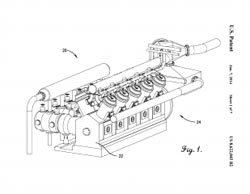Patented Airflow System Decreases Pollutants From Large Piston Engines

Kansas State University<br><br>Figure of the air control system from the patent paperwork.<br>
The system enables large-bore, multi-cylinder engines used in trains, pipelines, backup diesel generators and other fields to run efficiently while producing lower levels of harmful emissions than they do currently.
The patent, “Active Air Control,” was issued to the Kansas State University Research Foundation, a nonprofit corporation responsible for managing technology transfer activities at the university. The patent is for research by former faculty member Kirby Chapman and doctoral graduate Diana Grauer.
The Kansas State University-developed system uses an airflow sensor to measure and control the airflow rate into each piston in real time. Algorithms adjust the airflow accordingly and equalize the rate in multiple cylinders at the same time. This reduces the levels of nitrogen oxides produced during combustion in the engine.
The air control system offers a low-cost method to control and lower the production of nitrogen oxides and helps legacy engines meet compliance with EPA 2011 regulations. The system also was designed to fit various engine systems.
Kansas State University currently holds 100 active patents in its portfolio.
Media Contact
More Information:
http://www.k-state.eduAll latest news from the category: Machine Engineering
Machine engineering is one of Germany’s key industries. The importance of this segment has led to the creation of new university degree programs in fields such as production and logistics, process engineering, vehicle/automotive engineering, production engineering and aerospace engineering among others.
innovations-report offers informative reports and articles covering technologies such as automation, motion, power train, energy, conveyor, plastics, lightweight construction, logistics/warehousing, measurement systems, machine tools and control engineering.
Newest articles

A universal framework for spatial biology
SpatialData is a freely accessible tool to unify and integrate data from different omics technologies accounting for spatial information, which can provide holistic insights into health and disease. Biological processes…

How complex biological processes arise
A $20 million grant from the U.S. National Science Foundation (NSF) will support the establishment and operation of the National Synthesis Center for Emergence in the Molecular and Cellular Sciences (NCEMS) at…

Airborne single-photon lidar system achieves high-resolution 3D imaging
Compact, low-power system opens doors for photon-efficient drone and satellite-based environmental monitoring and mapping. Researchers have developed a compact and lightweight single-photon airborne lidar system that can acquire high-resolution 3D…





















